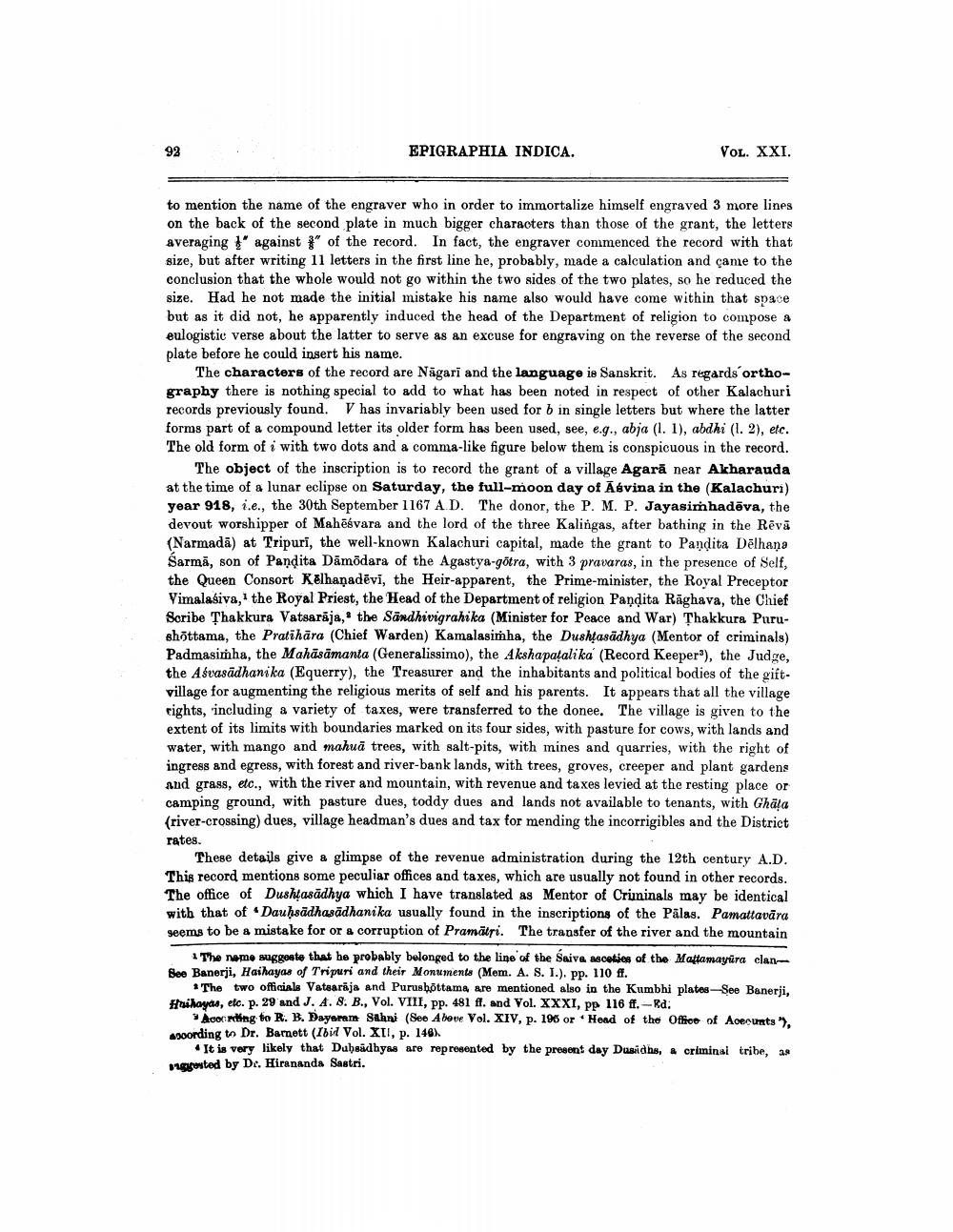________________
92
EPIGRAPHIA INDICA.
VOL. XXI.
to mention the name of the engraver who in order to immortalize himself engraved 3 more lines on the back of the second plate in much bigger characters than those of the grant, the letters averaging against of the record. In fact, the engraver commenced the record with that size, but after writing 11 letters in the first line he, probably, made a calculation and came to the conclusion that the whole would not go within the two sides of the two plates, so he reduced the size. Had he not made the initial mistake his name also would have come within that space but as it did not, he apparently induced the head of the Department of religion to compose a eulogistic verse about the latter to serve as an excuse for engraving on the reverse of the second plate before he could insert his name.
The characters of the record are Nāgari and the language ie Sanskrit. As regards orthography there is nothing special to add to what has been noted in respect of other Kalachuri records previously found. V has invariably been used for b in single letters but where the latter forms part of a compound letter its older form has been used, see, e.g., abja (1. 1), abdhi (1.2), etc. The old form of i with two dots and a comma-like figure below them is conspicuous in the record.
The object of the inscription is to record the grant of a village Agarā near Akharauda at the time of a lunar eclipse on Saturday, the full-moon day of Āøvina in the (Kalachuri) year 918, i.e., the 30th September 1167 AD. The donor, the P. M. P. Jayasimhadēva, the devout worshipper of Mahēsvara and the lord of the three Kalingas, after bathing in the Rēva (Narmadā) at Tripuri, the well-known Kalachuri capital, made the grant to Pandita Dēlhana Sarmā, son of Pandita Dāmödara of the Agastya-gotra, with 3 pravaras, in the presence of Self, the Queen Consort Kelhanadēvi, the Heir-apparent, the Prime-minister, the Royal Preceptor Vimalasiva, the Royal Priest, the Head of the Department of religion Pandita Rāghava, the Chief Scribe Thakkura Vatsarāja,. the Sāndhivigrahika (Minister for Peace and War) Thakkura Purushottama, the Pratihāra (Chief Warden) Kamalasimha, the Dushtasädhya (Mentor of criminals) Padmasimha, the Mahāsāmanta (Generalissimo), the Akshapatalika (Record Keeper®), the Judge, the Asvasādhanika (Equerry), the Treasurer and the inhabitants and political bodies of the giftvillage for augmenting the religious merits of self and his parents. It appears that all the village rights, including a variety of taxes, were transferred to the donee. The village is given to the extent of its limits with boundaries marked on its four sides, with pasture for cows, with lands and water, with mango and mahuā trees, with salt-pits, with mines and quarries, with the right of ingress and egress, with forest and river-bank lands, with trees, groves, creeper and plant gardens and grass, etc., with the river and mountain, with revenue and taxes levied at the resting place or camping ground, with pasture dues, toddy dues and lands not available to tenants, with Ghāla (river-crossing) dues, village headman's dues and tax for mending the incorrigibles and the District rates.
These details give a glimpse of the revenue administration during the 12th century A.D. This record mentions some peculiar offices and taxes, which are usually not found in other records. The office of Dushtasädhya which I have translated as Mentor of Crininals may be identical with that of Dauhsādhasādhanika usually found in the inscriptions of the Palas. Pamattavāra seems to be a mistake for or a corruption of Pramātri. The transfer of the river and the mountain
1 The neme suggeste that he probably belonged to the line of the Saiva Mooties of the Maftamayūra clanBee Banerji, Haihayas of Tripuri and their Monuments (Mem. A. S. 1.). pp. 110 ff.
* The two officials Vatearaja and Purushottama are mentioned also in the Kumbhi plates-See Banerji, Haihayas, etc. p. 29 and J. A. 8. B., Vol. VIII, pp. 481 ff. and Vol. XXXI, pp 116 ff. -Rd
Acorting to R. B. Dayaram Sahni (See Aleve Vol. XIV, p. 196 or Head of the Office of Acecunts). asoording to Dr. Barnett (Ibid Vol. XII, p. 146).
• It is very likely that Dubsadbyes are represented by the present day Dunidha, 4 criminal tribe, 19 suggested by De. Hirananda Sastri.




